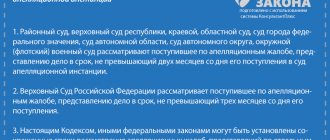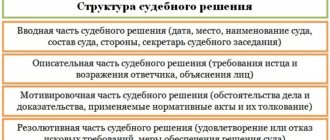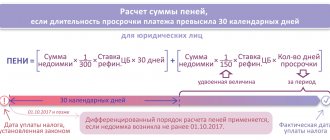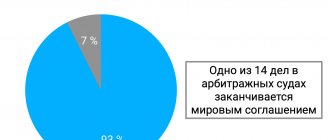(official current edition, full text of Article 224 of the Code of Civil Procedure of the Russian Federation)
| 1. Judicial decisions of the court of first instance, which do not resolve the case on the merits, are issued in the form of court rulings. Court rulings are made in the deliberation room in the manner prescribed by part one of Article 15 of this Code. 2. When resolving simple issues, the court or judge may make rulings without retiring to the deliberation room. Such determinations are recorded in the minutes of the court session. 3. Court rulings are announced immediately after they are issued. 4. A court ruling can be made in the form of an electronic document. When making a determination in the form of an electronic document, an additional copy of this determination is made on paper. |
Types of definitions in Article 224 of the Code of Civil Procedure of the Russian Federation
Definitions are divided into types. The most common are preparatory rulings, which ensure the progress of the process until the court resolves the case on the merits. They are issued both at the stage of initiating a case, preparing the case for trial, and at the stage of trial (clause 4 of Article 10 of the Code of Civil Procedure) and ensure the normal course of the process and facilitate the adoption of a lawful and informed decision.
Preparatory determinations are, for example, determinations on issues related to the progress of the case, for example:
- on acceptance of the statement of claim (Article 133),
- appointment of a case for trial (Article 153),
- on leaving the statement of claim without progress (Article 136),
- on attracting new participants in the process (Article - , - , clause 5, Article 10 of the Code of Civil Procedure, etc.).
Definitions related to the collection of evidentiary material are important. This occurs when it comes to:
- on requesting written evidence (Article 57),
- on securing evidence (Article 64),
- on calling witnesses (Article 69),
- on on-site inspection (Article 75),
- on storage and return of audio and video recordings (Article 77),
- on conducting an examination (Article 79),
- on obtaining handwriting samples for comparative study of the document and signature on the document (Article 81).
Preventive definitions are of great importance. Preventive definitions block the possibility of performing certain procedural actions. They do not affect the substance of the dispute. These include definitions:
- on refusal to accept a statement of claim (Article 134),
- on termination of proceedings in the case (Article 221).
All these determinations cannot be changed by the court that made them.
The final rulings conclude the consideration of the proceedings. They complete the process. These include determinations to terminate the proceedings due to the plaintiff’s abandonment of the claim or the parties’ conclusion of a settlement agreement (Article 220).
Is it possible to prove that the court ruling was made retroactively?
Good afternoon The civil trial ended in 2009. at the end of 2010 one of the parties learns that the opponent has two different court decisions in that process. In the process of establishing this fact and appealing (writing a statement to the prosecutor's office, the Department of Internal Affairs regarding the use of a deliberately false document.) the court did not allow access to the case materials for 2 weeks after writing the written statement. As a result, a ruling appeared in the case on correcting a clerical error, which fundamentally changes the meaning of the court decision and justifies the fact (so to speak) that the defendant-opponent has two versions of the court decision (duly certified). This definition is 100% invested and compiled recently, although it is said that it was adopted a year ago. Accordingly, a private complaint was filed for cancellation and a complaint against the judge to the qualification board.
Question: Is it possible and how can it be revealed and proven that the ruling was not made a year earlier and there was no hearing on the case? Thank you.
Mouse! White…
If you prove that the defendant has two decisions on his hands, and not a decision and a ruling. In any case, the judge will be called to the panel, and there he will already be tumbling. Because in such cases the robe is removed. And sometimes they are sent to the 51st Red Zone. In the Middle Ages, they took off the mantle along with the head.
The procedure for making rulings under Article 219 of the Code of Civil Procedure of the Russian Federation
Regardless of the nature of the case being resolved, the court, before making a ruling, must hear the opinions of the persons participating in the case. Along with this, the law provides for cases when a court ruling is made on a number of issues that are not always related to the consideration of the case in court (Article 119, 132, 136, 138, 139, 150, etc.). In cases provided for by law, court decisions in the form of rulings are made individually (Articles 147 - 153, 232, 248, 263, 437 - 440, 442).
The rules of Art. 15 Civil Procedure Code. Removal to the deliberation room is mandatory for making a number of determinations (Articles 220, 221, etc.). Determinations made in the deliberation room are signed by the entire composition of the court if there was a collegial resolution of the dispute.
The law provides for the possibility of issuing court decisions without going to the deliberation room. This applies to those issues that are not complex and require immediate resolution. The court may make a determination by deliberating on the spot, subject to certain conditions. For example, when the drafting of a ruling did not lead to disagreements in the composition of the court resolving this issue, if during a survey of persons participating in the case, a unanimous opinion was expressed, i.e. there were no contradictions, and finally, if the issue being resolved does not require a reasoned determination.
In all these cases, when a court ruling is made without removing the judges to the deliberation room, the court ruling is entered into the minutes of the court session, which is specifically provided for in Article 224 of the Code of Civil Procedure of the Russian Federation.
According to Art. 224 of the Code of Civil Procedure of the Russian Federation, court rulings must be announced immediately after they are issued. This means that in this case it is impossible to make only the operative part of the determination, applying by analogy Article 199 of the Code of Civil Procedure. The commented article strictly establishes the rule on issuing the full text of the ruling immediately, with its announcement at the court hearing.
Concept of terms
During the trial, different terms and definitions are used. To understand the proceedings, it is important to understand what the concepts in question mean.
The court's decision
This term refers to a judicial act that completes the consideration of a case. This document summarizes the results of the trial. It is distinguished by direct action and is subject to execution upon entry into force.
In criminal cases, the decision is made in the form of a sentence. It may be accusatory or acquittal. The structure of a procedural document includes several components. The most important are the motivational and operative parts. It is permissible to appeal a court decision in the manner prescribed by law. This is done by cassation or supervisory method.
Court ruling
This term refers to a judicial act that is passed during a meeting. It does not resolve the case on its merits, but is used to consolidate a specific action. This interim verdict is announced during the hearing. In this case, the court does not retire to the conference room.
Expert opinion
Karnaukh Ekaterina Vladimirovna
Graduated from the National University of Shipbuilding, majoring in Enterprise Economics
The determination may be issued as a separate document or adopted orally. At the same time, it must be included in the minutes of the meeting. It must be announced immediately. This option is used in all types of processes - administrative, civil, criminal.
Court rulings in the form of an electronic document
Court rulings issued in the form of a separate court ruling can be made in the form of an electronic document (Part 4 of Article 224 of the Code of Civil Procedure of the Russian Federation) and posted on the official website of the court, which significantly speeds up and facilitates familiarization with them for participants in the proceedings. Such a determination in form and content must necessarily comply with the general requirements for procedural documents, and for definitions in particular (see comments in Article 225 of the Code of Civil Procedure of the Russian Federation).
Unfortunately, the legislation does not provide for the mandatory posting on the official website of courts of general jurisdiction of all rulings issued in the form of a separate resolution. especially by a single judge, outside the court session. Therefore, it is impossible to familiarize yourself with such “intermediate” definitions on the official websites of courts of general jurisdiction at all levels. In our opinion, this drawback should be eliminated, since the time limit for appealing certain rulings is only 15 calendar days (Article 332 of the Code of Civil Procedure of the Russian Federation) days from the date of their issuance.
Life examples
Determinations in a civil case are adopted by the court of first instance as interim decisions. They include a number of required elements:
- name of the court;
- Full name of the judges;
- date and composition of participants;
- resolved issue;
- court decision - it indicates the reasons for the refusal or acceptance of the petition;
- procedure and deadlines for appeal.
As an example, we can give a situation: if the plaintiff writes a statement that he wants to leave the claim without consideration, the judge makes a ruling. Its essence lies in the fact that the case is closed based on the plaintiff’s statement.
If the plaintiff violated the procedure for applying to the court, did not provide the required documents or did not pay the state fee, the court may decide to leave the application without consideration.






